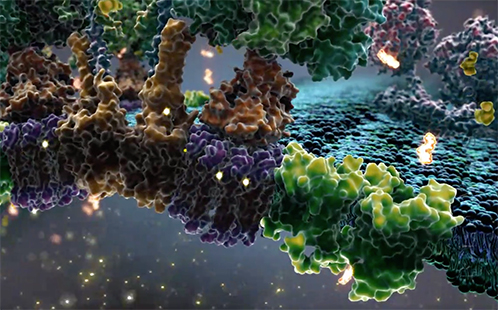Science lessons to be learnt from Hollywood blockbusters

Computer generated image of ATPase in Mitochondria
Science could learn a few lessons from Hollywood when it comes to inspiring a new generation of researchers, says the University of Western Sydney's Professor Roy Tasker.
"We spend too much time and energy drowning young minds in abstract symbolism and mathematical algorithms in science teaching, turning them off in droves," says Professor Tasker, the recipient of the 2011 Prime Minister's Award for Australian University Teacher of the Year.
"Instead, if we re-imagine how we teach science and include Hollywood-style special effects animations, we could inspire the next generation of researchers," he says.
"Science is all about explaining the observable world in terms of invisible, imperceptible worlds—too small, too big, or too strange to experience directly. Science teaching should focus much more on visualising these imperceptible worlds with mental models, empowering people to understand the everyday world, so they can create new insights and widgets."
Professor Tasker, who has already integrated stunning computer animations into his teaching to help students grasp complex scientific concepts and theories, recently received a prestigious Commonwealth Government Office for Learning & Teaching(opens in a new window) National Senior Teaching Fellowship. The Fellowship will allow him to research the world's best practices for computer visualisations and tap into current knowledge of how the brain processes audiovisual information to develop techniques to give students a deeper understanding of science.
"Visualising science has the aesthetic pleasure of art and theatre together with the intellectual satisfaction of genuine understanding, provoking an uncontrollable urge to ask more questions," says Professor Tasker.
"Young minds should be encouraged to think of the strange quantum world, and the non-intuitive rules governing it. Budding scientists also need to imagine and understand the molecular world so they can design new molecular machines to mimic and even improve upon the molecular machinery in cells."
"Visualisation of imperceptible phenomena is the key to making meaning from the symbolism and mathematics in science that too often alienate novice students."
"Only when you have useful visual mental models of these invisible worlds do you see the power of mathematics to generalise from the specific, and the need to communicate in scientific shorthand."
Students are embracing new technologies to engage with the world in creative ways, but the principles of science teaching have largely changed little in hundreds of years, says Professor Tasker.
"Rote learning of formulas, crunching equations and conducting experiments remain the pillars of all science teaching, but why not take advantage of powerful computer generated imagery to engage students and help them truly understand the abstract concepts of modern science."
Ends
Image credit: Medical Research Council(opens in a new window)
22 August 2014
Latest News

Opinion: What do we lose when our old suburbs disappear?
I live on the edge of Parramatta, Australia’s fastest-growing city.

Opinion: Most bees don’t die after stinging – and other surprising bee facts
Most of us have been stung by a bee and we know it’s not much fun. But maybe we also felt a tinge of regret, or vindication, knowing the offending bee will die. Right? Well, for 99.96% of bee species, that’s not actually the case.

Western Sydney University receives transformational donation to support LGBTIQA+ community
Western Sydney University has welcomed a philanthropic donation from The Brennan Lynch Foundation.
Mobile options:

